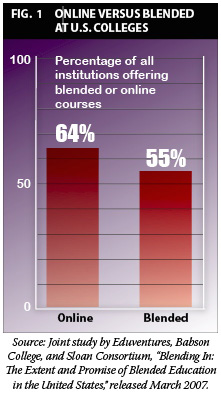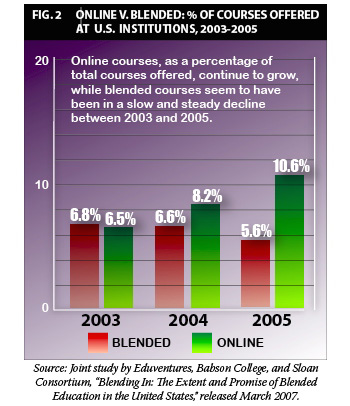Research: Blended Versus Online Learning
A report released this week by Eduventures, Sloan Consortium, and Babson College, shows a slow but steady decline in the percentage of blended courses offered by colleges and universities, while purely online courses continue to grow. At the same time, the report found that colleges and universities have not been meeting consumer demand for online course offerings.

The report, "Blending In: The Extent and Promise of Blended Education in the United States," found that 55 percent of all institutions in the United States offer at least one blended course, while 64 percent offer at least one online course (Fig. 1).
The survey, now in its third year, also found that the number of blended courses offered as a percentage of total courses offered has declined slowly but steadily from 2003 to 2005, while, at the same time, the percentage of purely online courses has increased (Fig. 2). In 2003, blended courses represented 6.8 percent of total courses; in 2004, that number dropped slightly to 6.6 percent; and, in 2005, it dropped further to 5.6 percent. Online learning as a percentage of total courses offered was at 6.5 percent in 2003, 8.2 percent in 2004, and 10.6 percent in 2005.
At the same time, consumers, according to the survey, have responded overwhelmingly positively to online or blended learning. Some 76 percent of consumers interested in a post-secondary education expressed a desire for courses with some sort of online component. And 81 percent expressed a preference for courses with some sort of face to face component. Nineteen percent said they would prefer wholly online programs; and 32 percent reported a preference for either a primarily online program or a balanced online/on site program. Of those responding, 10.6 percent reported previous experience with wholly online programs, and 16.6 percent reported experience with blended programs.

Findings in the study are based on a national survey of colleges and universities in the United States and was conducted by the Babson Survey Research Group and funded by the Alfred P. Sloan Foundation. Additional results within the study were provided by an Eduventures national survey of 2,033 U.S. adults interested in postsecondary education.
The complete report is available free of charge. (See link below.)
Read More: